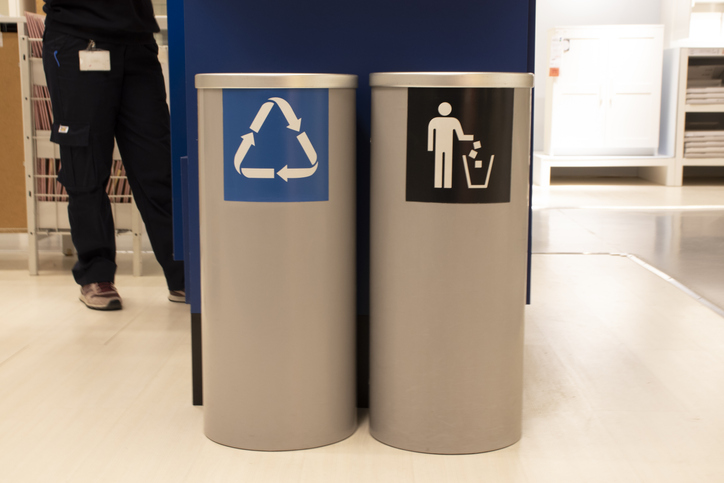7 Steps to Develop an Effective Recycling Program

Today, many businesses are seeking to reduce and minimize the amount of waste going to landfills. When it comes to waste and recycling management, understanding your waste streams and what recycling initiatives your business can accommodate can be tricky. Regardless of whether you are looking to create a program from scratch or alter what is currently in place, here are seven steps to help you on your quest towards a more effective recycling program.
7 Steps to Develop an Effective Recycling Program
Today, many businesses are seeking to reduce and minimize the amount of waste going to landfills. When it comes to waste and recycling management, understanding your waste streams and what recycling initiatives your business can accommodate can be tricky. Regardless of whether you are looking to create a program from scratch or alter what is currently in place, here are seven steps to help you on your quest towards a more effective recycling program.
#1: Start with a Waste Audit
The first step is to perform a thorough waste audit. Take a look at your current waste management procedures and practices to better understand how and if recycling fits into your overall program and budget. Key questions to consider include:
- What materials are in your current waste stream? What is the volume of each material being produced?
- What type of disposal equipment do you currently have? For example, compactors, open tops, balers, etc.
- Do you know your calculated monthly expense on disposing all your materials?
- Are you currently recycling or reusing any materials?
- How many locations do you have?
- Are you using any reporting metrics to determine your current diversion ratio?
- Are you storing any recyclable materials at any of your locations?
#2: Identify Options
Upon completion of your waste audit, you will have a thorough picture of your waste streams. This will allow you to identify opportunities to create or supplement a recycling program for your business. When planning out your recycling program, you’ll want to consider the following:
- Space – Do you have enough room at your business location(s) to support the recycling initiatives you’d like to implement?
- Commodity type – What recyclable materials are you producing?
- Volume and equipment size – Based on the amount of materials you’re producing, what equipment is going to best suit your needs? And, based on the volume of each, does it make financial sense for your business to recycle?
#3: Understand Costs
Be sure to analyze the cost structure of any recycling service to ensure it makes the most sense for your business and bottom line. Your program’s cost will depend heavily on the type of recycling materials, the current market value of those materials, the volume your business is producing and hauling costs. It’s essential to ask your managed waste service provider or vendor what the available options are, including any available rebates.
#4: Create Attainable Goals
The key is to start small. Don’t make extensive changes all at once. Establish small, attainable goals that you can implement over time while outlining accountability touchpoints to ensure that your program is functioning as it should or if any adjustments need to be made to ensure success.
Many businesses already have specific corporate sustainability initiatives in place. If your business does, now is a great time to assess how your recycling program will ladder up to specific goals. Alternatively, it could be a whole new area of expansion within your sustainability initiatives.
#5: Inform Employees
Laying the foundation for your recycling program is key, but maintaining it over time is just as important. Employees can play a large part in your recycling efforts and getting them on board from the start will benefit the success of your efforts. Education is critical. Consistent communication will help foster a better understanding of what your business is doing and how employees can actively participate.
Tactics such as monthly email sustainability updates or proper signage including do’s and don’ts – such as accepted materials and instructions for proper recycling to avoid contamination — can help ensure employees are following the appropriate measures to participate most effectively in company-wide recycling initiatives.
#6: Monitor and Track Program Efforts
Even after the initial waste audit has been completed, monitoring shouldn’t stop. Make sure to set a regular schedule to re-evaluate program success and make any necessary adjustments. Things change over time, and that may mean you need to make some small tweaks to your program to keep it operating as efficiently as possible.
Talk with your managed waste service provider or vendor about any tracking platforms they may have to help you measure your recycling program. Many offer technology platforms, such as cloud-based monitoring systems, that will assist you in your recycling planning and maintenance efforts over time.
A waste and recycling tracking system will let you analyze your current waste spend and give you a real-time glimpse into your recycling streams. The consistent data will allow you to make any pertinent updates or improvements over time – whether that may be rightsizing your equipment, increasing the number of hauls to temporarily accommodate peak times or seasonal changes, or improving your recycling diversion rates. The data generated from the tracking system will provide you with the data you need to keep your recycling program on track to meet your goals.
#7: Stay Informed
It’s important to stay up to date on the global state of recycling. It’s heavily impacted by market fluctuations, which may affect your sustainability efforts depending on what materials you’re recycling. The value of materials will vary based on the economy and market conditions, which can directly cause a shift in your program’s costs. You can stay up to date by keeping an open line of communication with your vendor and subscribing to recycling resources and newsletters.


